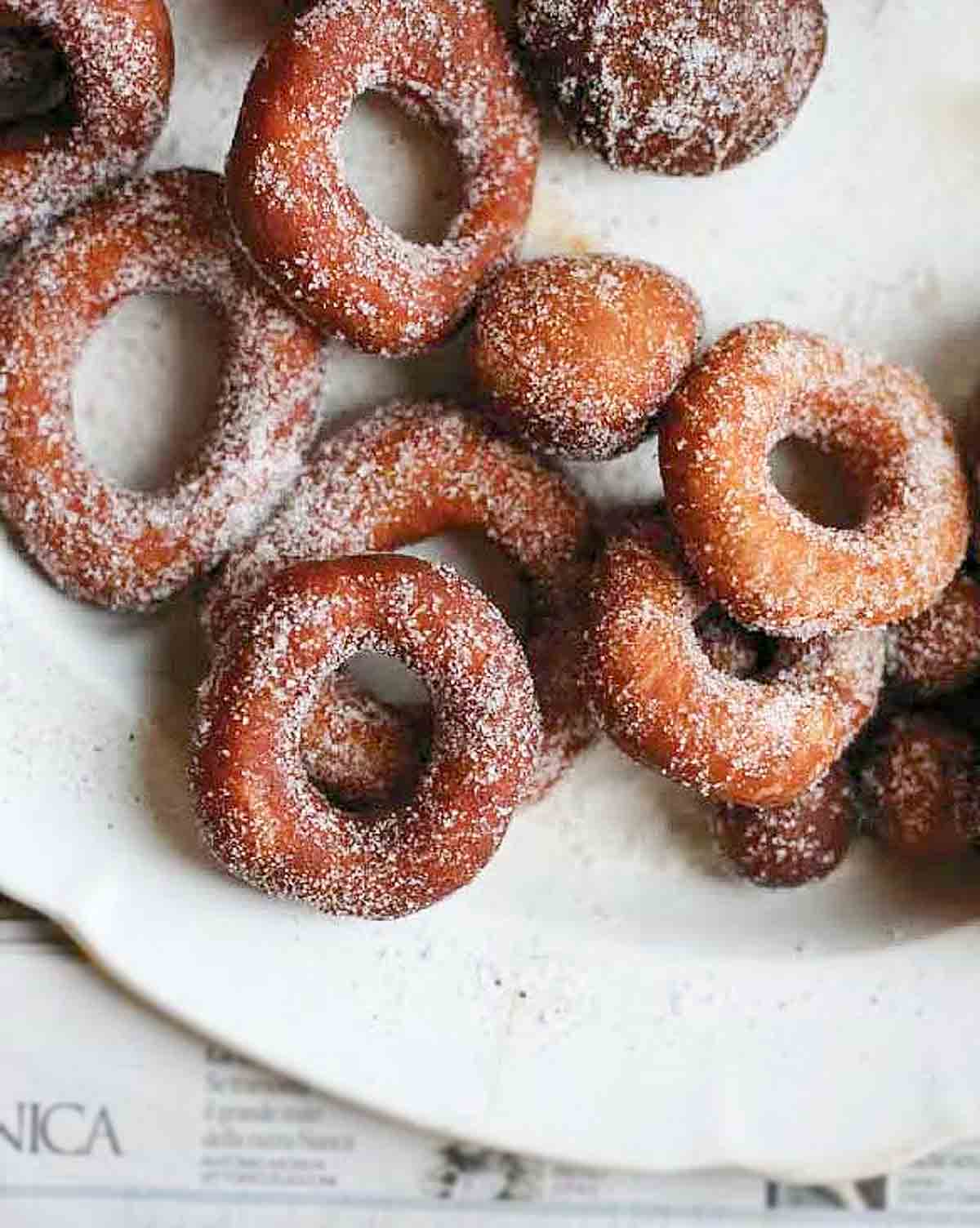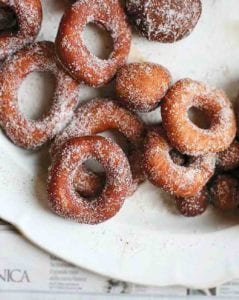
Essentially a brioche dough made with lard instead of butter, this pastry is a slightly richer recipe than Sicilians usually admit to. The delicious result reminds me of early mornings when my uncle took my cousins and me to school and would treat us to warm doughnuts dripping with marmalade. Irresistible!–Fabrizia Lanza
What are cuddureddi?
Cuddureddi. That means the holidays are coming if you’re from the south of Italy. Well, technically it means an easy doughnut recipe that’s essentially denser and less sweet than the typical American Glazed Doughnut is coming. But in Italy, this easy doughnut recipe is synonymous with celebration. So go on. Celebrate.

Easy Raised Doughnuts ~ Cuddureddi
Equipment
- 3-inch round doughnut or cookie cutter; deep-fry or candy thermometer
Ingredients
- 2 1/2 cups all-purpose flour, plus more for the work surface
- 2 teaspoons active dry yeast or fresh compressed yeast
- 1 1/4 cups whole milk, lukewarm
- 1 tablespoon lard
- Pinch fine sea salt
- mild vegetable oil, for frying
- 1 cup granulated sugar
- 1 teaspoon ground cinnamon
Instructions
- Mound the flour on a work surface and make a well in the center. Add the yeast, milk, lard, and salt to the well. Gradually stir in enough flour with your hands to form a paste, then work in the remaining flour to form a dough and knead until very smooth. (The dough will still be quite sticky at first, but refrain from adding more flour. It may take up to 30 kneads or so before the dough smooths.)
- On a floured work surface using a rolling pin, roll the dough out to a 1-inch thickness, then cut into rounds with a 3-inch doughnut or cookie cutter. Cut the holes from the middle with a smaller cutter (or, in a pinch, the cap of a soy sauce or other smallish bottle).
- Place the cut pieces of dough on a baking sheet lined with parchment paper and let rise for about 30 minutes.
- In a deep, heavy skillet, preferably cast-iron, heat 2 inches of oil over medium-high heat until it measures about 350°F. Slip a few pieces of dough into the hot oil and fry until golden brown, 1 to 2 minutes, then flip carefully and fry until the other side is golden brown, another minute or so.
- Using a slotted spoon or skimmer, remove dough from oil and place on paper towels to drain. Repeat with the remaining dough.
- In a shallow bowl or in a brown paper bag, mix together the sugar and cinnamon and dredge or shake the cuddureddi in the sugar mixture. Serve the doughnuts warm.

Explore More with AI
Nutrition
Nutrition information is automatically calculated, so should only be used as an approximation.
Recipe Testers’ Reviews
I really love this simple doughnut recipe. I used the ingredients that I had on hand—heavy cream and instant yeast—and, as you may have guessed, this worked perfectly. I had a three-inch biscuit cutter, but no cutter small enough for the center hole. I opted to use the lid from a bottle of soy sauce. Necessity, as they say, is the mother of invention. These doughnuts are simple and bland, which make them the PERFECT vehicle for using your imagination. Apple pie spices or pumpkin pie spices in the batter come to mind. Chocolate icing or, as the recipe calls for, sugar and cinnamon. With this simple recipe, ANYONE will look like an experienced baker.
These were nicely chewy on the outside and tender on the inside. As the recipe states, the dough is quite sticky, but I found that by sprinkling it with a little extra flour, it handled perfectly. For the cinnamon sugar, half of the amount stated in the recipe was more than enough for my 17 doughnuts. They were most delicious shortly after they came out of the oven, but even after a couple of days they were still very enjoyable.
Easy homemade doughnuts! What’s not to love? This was my first—but will not be my last—attempt at making doughnuts. I’d never tried Cuddureddi before, and I would describe them as a little more dense than the typical American glazed yeast doughnuts I get from my local doughnut shop. That said, these doughnuts are still airy and quite delicious. They’re best served warm, rather than at room temperature, in my opinion.
I like that the recipe is straightforward and didn’t require a long or complicated rising time. From start to finish, the recipe took me 45 minutes to make. The dough is very sticky, just like the recipe says. At first, my instinct was to add more flour as I was kneading. My thoughts were that the dough would not come together, but after about 30 kneads by hand, it did come together into a nice, smooth consistency. I did not have fresh yeast so I substituted an equal amount of active dry yeast. Since I used active dry yeast, I brought my milk up to 110° F (I used the milk frothing function on my espresso machine to heat the milk, and a thermometer to gauge the temp) and then added my yeast directly into the milk to help it dissolve.
These doughnuts fry up in a matter of minutes, no more than 1 to 2 minutes per side. I got out my 10 1/2-inch cast-iron skillet for frying and fried them at 350°F using rice bran oil, which has a high smoke point. It’s all I had in the cupboard and the oil was very neutral-flavored. I loved that these were not greasy at all! I drained them on a paper towel and then threw them in a double-lined paper bag, poured in the cinnamon sugar, and gently shook the bag. The paper bag method was a great way to coat the doughnuts without a mess on my hands. I actually cut the recipe in half and made a half batch, which yielded 10 donuts. I wish these were a bit more airy or lighter in texture, but maybe that is the way they are supposed to be?
There could not have been a better recipe to make during my family vacation. Born of a doughnut-obsessed mother, for whom we used to plunge a lit candle into a stacked dozen in lieu of a cake every year, I knew this could be a real crowd-pleaser. Much to my surprise, the recipe was quite simple and also extremely forgiving of MacGyver-esque alterations, which is rather unheard of for baking. My testers gave the fried dough 10s all around, specifically citing the crisp outside but light inside and mild sweetness as the objects of their admiration. Personally, I prefer an even yeastier, doughier doughnut, and am curious if butter instead of lard would have lent a richer flavor; all the same, I enjoyed them thoroughly. I might recommend a tad more cinnamon in the coating, and maybe just a hint of sweetener in the dough itself.
I couldn’t find compressed yeast, so I used a packet of dry active yeast dissolved in 1/2 cup warm water, and thus used 1/2 cup less milk (which was still a bit cold and actually a mix of half-and-half and 1%). As for the flour, it was not robust enough to contain 1 1/4 cups liquid, so the mixing process was terribly sloppy. But it all came together eventually by adding the liquid gradually and using my hands to contain the leakage. The formed dough was way too sticky to knead, so I added a fair amount of extra flour in order to handle it at all. The instruction to knead until “smooth” was not particularly helpful; I ended up not so much kneading it until smooth as pushing it around for about 3 minutes until workable and not so bumpy. That small amount of dough barely needed to be rolled out to achieve the 1-inch thickness. I cut out about 5 doughnuts (probably more like 4 inches across) using a floured, upturned glass and a cap, then rerolled the excess to make 3 more, and saved the punched-out holes as well. To my surprise given the yeast adjustments and kneading difficulties, they rose beautifully. As the frying temperature was also somewhat ambiguous, I heated the oil for about 15 minutes on medium-high, until a doughnut hole began to sizzle when added. The frying time was accurate—2 to 3 minutes total—though I removed them when they were lightly browned rather than golden-brown. My advice is to dip them in the cinnamon-sugar mixture almost immediately, as the grease drains off quickly and the coating will adhere better if the doughnut is still hot. Regardless, you can always redip the doughnuts, or brush some of the sugar off, to accommodate people’s preferences. One more warning—I don’t know about your family, but the stated yield of 8 servings was a gross overestimate to those with healthy sweet tooths (sweet teeth?) eagerly in waiting.













Being half Sicilian and half Calabrase, we would make these every year at Christmas time. Always they would be made with potatoes as the base rather than “just” flour. We would fry them plain or stuff them with an anchovy and then fry them. They were enjoyed in the afternoon before our big, Christmas eve fish dinner. Will have to try these to see how they taste.
I, too, grew up on doughnuts made with potatoes, Debbie D. And damn, they were good. Can’t wait to hear what you think of these…